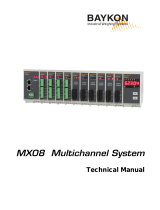
Complex command requires setting the address of
a respective parameter (from 2 to 24 – refer to: "Complex
command parameters").
A complex command is executed once upon detecting that
its bit has been set. If the command is to be executed more
than once, it is necessary to zero the bit first, and reset it to
the required value next
Example:
Sending tare of 1.0 value to the scale
Performance of the command requires record of 2 registers:
1. Complex command - value 0x01 – i.e. tare setting.
2. Tare – value 1.0 (0x3F800000).
Tare – complex command parameter: tare value (in an adjustment unit).
LO threshold – complex command parameter: LO threshold value (in an
adjustment unit).
Output state – complex command parameter: determination of platform output
state.
Example:
Setting high state for output 1 of the platform.
Output mask:
Upon conversion to HEX the result is 0x01
Performance of the command requires record of 2 registers:
1. Complex command - value 0x02 – i.e. output state setting.
2. Output mask – value 0x01.
MIN – complex command parameter: MIN threshold value (in the unit set for
the active working mode).
MAX – complex command parameter: MAX threshold value (in the unit set for
the active working mode).





















